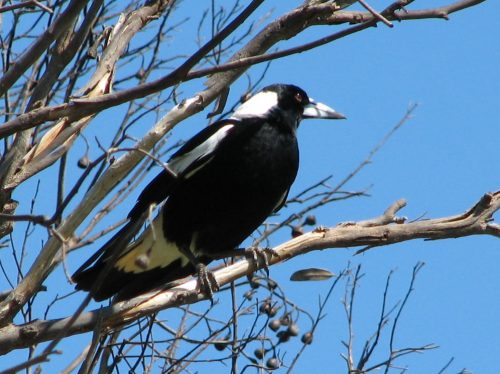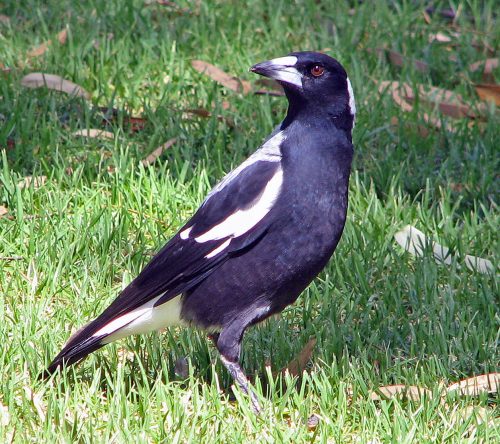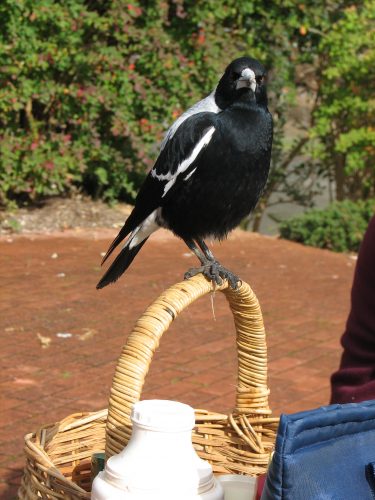Reflections on an old story

Australian Magpie
Memory lane
I have been having a trip down memory lane in recent days. I have been typing up an old story I wrote many years ago. In fact, the only copy I appear to have is a typed copy with 1989 on the title page. I was shocked to realise that this story was written nearly 28 years ago. It has languished ever since as one or two copies stored in boxes in our garage. The copy I am using was printed on an old dot-matrix printer. Remember those old clunkers?
Early computers
This story, called Magpie Farm (hence the photo of an Australian Magpies above and below), was typed on either a borrowed Commodore 64 computer or on the Amigo 500 I bought around that time. I can’t remember. I think that it was written during a school holiday break; I was a classroom teacher at the time. Those old computers were wonderful, and I learned so many things about the digital world from them. I still have the old Amiga – in working condition too, though I only fire it up every five years or so. Sadly, the old Amiga discs are not compatible with today’s PCs, hence the need to retype this story.
First novel
I am sure that this was my first attempt at writing a novel for children. At just under 10,000 words it is probably better described as a chapter book. I have since written several more novels for children, of varying lengths and subject matter. I am planning to prepare these for publication sometime this year. They will initially be in eBook format with print on demand paper copies also available.
Background to Magpie Farm
As I type up this story, I recognise many incidents from real life. The main character is a young boy who is afraid of magpies. Some Australian Magpies are notorious for their tendency to swoop people during the breeding season. The boy’s family move to a small farm and he is horrified that there are magpies on the farm. Some of the incidents I have included in the story are drawn directly from my own family’s experiences. A few years before writing this story, we also bought some acreage, though five acres (two hectares) can hardly be called a “farm”. We did have some sheep for a while; I’m not sure if that qualifies it as being a farm.
A problem
I have a serious problem with the story. Several problems, actually.
It is terrible.
Honestly – it needs some serious editing, rewriting and restructuring. The problem is that I have decided to be very strong as I type it up. I tend to edit as I type. This applies to most of my writing these days. The first draft is often very close to the final draft. I rewrite, edit, proofread and so on as I go. Not always, but usually that is my preferred writing style. This time I decided to be very strong and resist all urges to stop and rewrite, edit or change anything. Those steps will come later.
Why is it terrible?
As I type, I find myself wincing often. How could I have written such terrible prose? The dialogue between characters is not all that bad, but the rest of it is quite naive – almost childish. This shows up three basic things:
- I have certainly progressed a long, long way as a writer in the intervening years.
- There is much good material in the story which can be vastly improved.
- I now know what is wrong with the story and the writing, and how to fix it; that comes with experience and heaps of writing practice (over 3 million words later, and counting).
Where to now?
I still have a few chapters to type up. Then I will spend a week or two rewriting whole slabs of the text to bring it up to publishable standards. Later will come the proofreading and copy editing stages before I send my baby out into the world. After that, I have two other longer novels written several years later and they will both need the same treatment.
Is it all worth it?
If the story as it stands now is so terrible in my own eyes, is it worth pursuing and putting in all that work? I believe so. I take this attitude, not because it was my first serious attempt at a novel, but because of feedback from readers.
- At the time I printed out a number of copies and handed them out to friends. They all commented how good it was, and how much they enjoyed it.
- I also read it to several classes I was teaching at the time of writing. I still have contact with many former students who remember the story well.
- I was asked recently by one former student if I had published this story. He added that it had a profound, positive effect on him. It inspired him to become a writer. He has published some of his writing, he has participated successfully in performance poetry events, and he wrote and performed in a musical which was showcased last week at the Adelaide Fringe Festival. This festival is regarded worldwide as second only to the Edinburgh Fringe Festival.
- Wow! I love feedback like that.
Stay tuned
I plan to publish this chapter book (novel?) in the near future, so stay tuned. The launch will be announced on this site, and it will be available through this site.
Good reading. Good writing.
Trevor
Further reading:
- Trevor’s Birding – check out another blog of mine where I also write regularly about Australian birds. I showcase many of my bird photos on that site.

Australian Magpie

Australian Magpie
Writing children’s books
I am currently visiting my grandchildren who live interstate. It’s a joy I have only a few times every year, but so interesting to see their development and to play with them a whole range of games. Their ages are 4 and 1, so they are still developing in many ways, especially in their imaginations.
One of the special delights is cuddling up for story time. Both parents are book lovers, so their home has many books. Family and friends have also made sure the two little ones have plenty of books in their lives. And to add to the wonderful books in the home, a new branch library has just recently opened up in an old church building five minutes’ walk up the road.
In reading books daily to the grandchildren – and sometimes several times a day – once again has impressed upon me the importance of reading in the life of a child. So much language development occurs in this pre-school period. So many books are rich in wonderful language. But more than that, there is so much cultural heritage which can be absorbed by the young, developing mind. There are also the many environmental concepts which can also be introduced through non fiction. Last night my grandson and I spent nearly an hour pouring over a book about farming; he lives in Australia”s largest city so this is an excellent way of talking about my heritage; I grew up on a farm.
The case for reading to and with children is so important and soundly supported by the research. What is less emphasised, I feel, is the importance of reading children’s books if one desires to be writing children’s books. Just like in the importance of books in the life of a developing child, so is the reading of children’s books vital in the development of the aspiring children’s authors. You cannot read too many, and there are so many wonderful children’s books out there now you will certainly be entertained for many years to come.
Good reading.
Good writing.
Reading children’s literature
One of the units of study I have lectured in at university this year has been Children’s Literature, with a particular focus on using children’s literature in the classroom. All of my students for this unit are teachers in training, all of them eager to gather ideas for incorporating literature in their future classrooms.
It has been a rewarding time for me as it has renewed my enthusiasm for reading children’s literature. When I was a classroom teacher, and earlier in my career when I was a teacher/librarian, I would regard the reading of children’s books as a professional requirement. I am a voracious reader, so this was no hardship. After one little forgettable incident, I resolved never to read a book to a class without having read it privately first. I still believe this to be a wise policy for any classroom teacher or children’s librarian.
In recent months I have read a wide variety of picture books, chapter books for emerging readers, novels for older readers and non-fiction for various year levels. Sadly, I haven’t had time to review any of them here. In time I hope to regularly get back to reviewing the books I read. In the meantime, if it has been some time since reading a children’s book, why not borrow a few from your local library? Many of the titles published in the last decade are fine examples of excellent writing; some are just as challenging to read as adult books. And often far more interesting and captivating.
If you read a good book that you’d like to recommend – children’s or other – write about it in the comments section. I’d like to know, and so would my readers, I’m sure.
Good reading – and writing.